Bibha Chowdhuri- The Beam of Light that Lit the Path for Women in Indian Science NCERT Solutions | English Poorvi Class 8 - New NCERT PDF Download
| Table of contents |

|
| Page No. 233 |

|
| Page No. 237-244 |

|
| Page No. 245-246 |

|
| Page No. 247-248 |

|
Page No. 233
Let us do these activities before we read.
I. Work in pairs. What qualities do you associate with a scientist? Share your answers with your classmates and teacher. Complete the word web given below.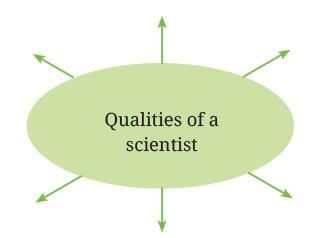 Ans:
Ans:
Some qualities associated with a scientist may include: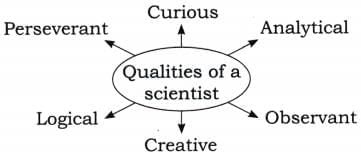
II. Some pictures of women scientists are given below. What do you know about their work? Share your answers with your classmates and teacher.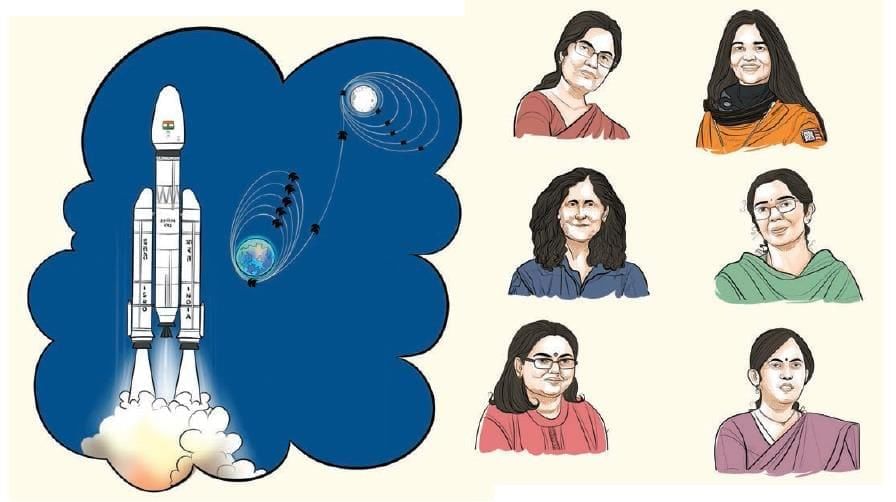 Ans:
Ans:
1. Kalpana Chawla – The first woman of Indian origin to go to space. She was an astronaut with NASA and died in the Space Shuttle Columbia disaster in 2003.
2. Dr. Tessy Thomas – Known as the “Missile Woman of India,” she played a key role in the Agni missile project at DRDO.
3. Dr. Ritu Karidhal – Known as the “Rocket Woman of India,” she was Deputy Operations Director of ISRO’s Mars Orbiter Mission and led Chandrayaan-2.
4. Dr. Indira Hinduja – A pioneer in reproductive medicine in India, she delivered the country’s first test-tube baby.
Page No. 237-244
Let us think and reflect
I. Arrange the following events from Bibha Chowdhuri’s life in the correct order of occurrence. Share your answers with your classmates and teacher.
1. The International Astronomical Union (IAU) honoured her legacy by renaming a star in the constellation Leo—HD 86081—as ‘Bibha’.
2. She became the first woman faculty member at the Tata Institute of Fundamental Research (TIFR).
3. Bibha Chowdhuri was born in pre-independent India.
4. The Government of India declared a chair professorship in Bibha’s name.
5. She joined the University of Manchester under the guidance of the celebrated Nobel Laureate, Patrick M.S. Blackett.
6. She was nominated for a Nobel Prize by Erwin Schrodinger.
Ans:
3 → 5 → 6 → 2 → 1 → 4
Let us think and reflect
I. Read the given extracts and answer the questions that follow.
1. In 1945, Bibha’s academic journey took her to the University of Manchester. Under the guidance of the celebrated Nobel Laureate, Patrick M.S. Blackett, she delved deeper into the field of cosmic rays. Her Ph.D. thesis on cosmic rays earned local recognition, with newspapers introducing her as ‘India’s New Woman Scientist—She has an eye for Cosmic Rays’.
(i) Why is the mention of Patrick M.S. Blackett, a Nobel Laureate, significant in this extract?
Ans:
The mention of Patrick M.S. Blackett is significant because it shows that Bibha was working under one of the most respected and renowned scientists of the time, highlighting the calibre of her research and the respect she had earned in the field of physics.
(ii) What can be inferred about the public perception of women scientists in the 1940s from the title given to her by the press ‘India’s New Woman Scientist’?
A. Women scientists were widely accepted and celebrated at that time.
B. The world was still doubtful about the capabilities of women scientists.
C. Women scientists were as common and renowned as men in the 1940s.
D. Women were not allowed to study sciences or pursue scientific careers.
Ans: (B) The world was still doubtful about the capabilities of women scientists.
(iii) In the phrase ‘celebrated Nobel Laureate,’ the word ‘celebrated’ refers to all of the following EXCEPT someone who is
A. famous and highly respected
B. frequently seen in public
C. renowned for their achievements
D. well-regarded in their field
Ans: (B) frequently seen in public
(iv) Complete the following sentence suitably.
The phrase ‘She has an eye for Cosmic Rays’ suggests that ____________
Ans:
The phrase ‘She has an eye for Cosmic Rays’ suggests that she had a deep understanding and insight into the study of cosmic rays.
2. The journey from Bibha Chowdhuri’s era to today’s women scientists has been long and arduous, but it is also inspiring. The struggles Chowdhuri faced are a stark reminder of how far we’ve come—and how much Jiirther we have to go. But with every cosmic achievement— be it landing on the moon or reaching Mars—these women prove that the journey is well worth it. Bibha Chowdhuri’s legacy lives on. Her story continues to inspire young women to pursue their passions, break barriers, and leave their mark on the world. As the stars of Indian science shine brighter, Bibha Chowdhuri, the beacon-beam of light, ’ will always guide the way.
(i) What can be inferred about the challenges faced by women scientists today, as compared to Bibha Chowdhuri’s era?
A. Women scientists no longer face any barriers.
B. The challenges remain, but progress has been made.
C. The struggles have become more difficult over time.
D. The struggles are the same as they were for Chowdhuri.
Ans: (B) The challenges remain, but progress has been made.
(ii) The phrase ‘Bibha Chowdhuri’s legacy lives on’ suggests that ____________
Ans: The phrase ‘Bibha Chowdhuri’s legacy lives on’ suggests that her contributions continue to inspire and influence future generations.
(iii) Why is Bibha Chowdhuri referred to as a “beacon’ and a “beam of light’ in the extract?
Ans: Because she led the way for women in science through her courage, dedication, and pioneering work, giving hope and inspiration to others.
(iv) State whether the following sentence is a fact or an opinion.
Bibha Chowdhuri was the beacon, the ‘beam of light’ whose story continues to inspire young women.
Ans: Opinion – It reflects the writer’s admiration and interpretation of her legacy.
II. Answer the following questions.
Q1: Why is Bibha Chowdhuri considered a pioneer in the field of science?
Ans: Bibha Chowdhuri is considered a pioneer because she was the first Indian woman physicist to work in the highly specialized field of high-energy particle physics. She broke gender barriers, conducted crucial research on cosmic rays and subatomic particles, and paved the way for future women in Indian science.
Q2: What does Bibha Chowdhuri’s nomination by Erwin Schrodinger tell us about her abilities?
Ans: It shows that Bibha Chowdhuri’s scientific work was of exceptional quality and internationally recognized. Being nominated for a Nobel Prize by a renowned scientist like Erwin Schrodinger indicates her outstanding contributions and talent.
Q3: Bibha Chowdhuri never worked for awards or recognition. Support this statement with evidence from the text.
Ans: Despite her groundbreaking work, Bibha Chowdhuri never received any awards during her lifetime. She continued her research tirelessly, often working in the background, focusing on her passion for science rather than seeking fame or recognition.
Q4: How does the renaming of a star as ‘Bibha’ serve as both a literal and symbolic recognition of her contributions to science?
Ans: Literally, it immortalizes her name in the cosmos, while symbolically, it reflects the “beam of light” she represented in science—illuminating the path for future generations and acknowledging her once-forgotten brilliance.
Q5: How do the roles of women in ISRO today reflect broader changes in societal attitudes towards women in STEM in India?
Ans: Women in ISRO today hold leadership roles in major space missions, showing that societal attitudes have shifted to recognize and support women’s capabilities in science and technology. This progress is rooted in the pioneering efforts of women like Bibha Chowdhuri.
Q6: What is the writer’s purpose of highlighting the contributions of Bibha Chowdhuri and other modern women scientists?
Ans: The writer aims to inspire readers, especially young girls, by showcasing how women have overcome challenges to excel in science. It also seeks to acknowledge unsung heroes and promote gender equality in STEM fields.
Q7. How might this text help shape people’s perception of the role of women in other traditionally male-dominated fields?
Ans: This text challenges stereotypes and encourages society to view women as equally capable in all fields, including those traditionally dominated by men. It motivates individuals to support and recognize women’s contributions across professions.
Let us learn
I. Complete the crossword puzzle by filling in the antonyms from the clues given below in the table. You may refer to the text.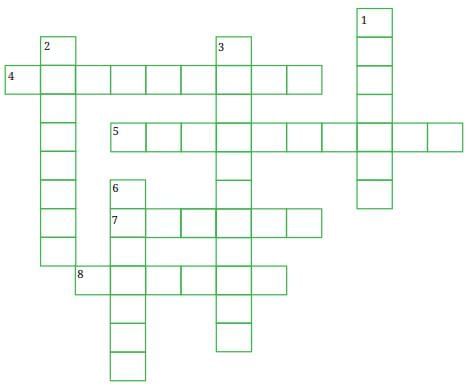
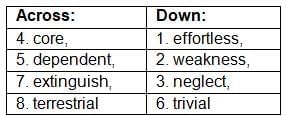 Ans:
Ans: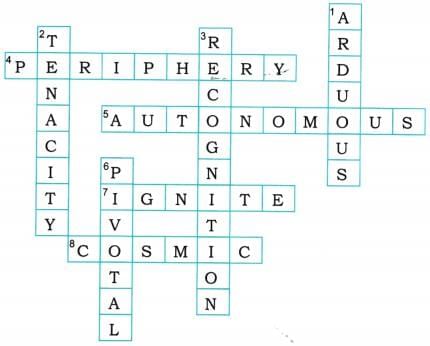
II. Substitute the underlined phrase in the sentences with the suitable words from the box given below. 1. They are considered to be the first people to start the online markets.
1. They are considered to be the first people to start the online markets.
2. A scientist who studies matter, energy, light, etc.
3. Most of my friends are my classmates and are my age.
4. We first welcomed all the famous and important people in folk song for the award ceremony.
5. My brother finally succeeded in his business because of his continuous efforts and determination.
6. We should remove all the things that block our way in achieving success
Ans:
1. Pioneers
2. Physicist
3. Peers
4. Luminaries
5. Persistence
6. Barriers
III. The words ‘professorship’, ‘mentorship’, and ‘leadership’ are used in the text. These words are made by adding the suffix ‘-ship’ to the words ‘professor’, ‘mentor’ and ‘leader’. Similarly, we can make words by adding -ment and -hood to certain words.
Now, make words by adding suitable suffixes -ship, -ment, and -hood to the words given below. One example has been done for you.
achieve + ment = achievement
1. member + _______________ = _________________
2. govern + _______________ = _________________
3. partner + _______________ = _________________
4. child + _______________ = _________________
5. citizen + _______________ = _________________
6. entertain + _______________ = _________________
7. brother + _______________ = _________________
8. agree + _______________ = _________________
Ans:
1. member + ship = membership
2. govern + ment = government
3. partner + ship = partnership
4. child + hood = childhood
5. citizen + ship = citizenship
6. entertain + ment = entertainment
7. brother + hood = brotherhood
8. agree + ment = agreement
IV. The abbreviations—ISRO and STEM— used in the text are called acronyms because they are read or pronounced as full words.
The grid given below has acronyms for the following. Circle the acronyms in the grid.
1. National Aeronautics and Space Administration
2. All India Institute of Medical Sciences
3. Ayurveda, Yoga and Naturopathy, Unani, Siddha, and Homoeopathy
4. National Institute of Pharmaceutical Education and Research
5. World Health Organization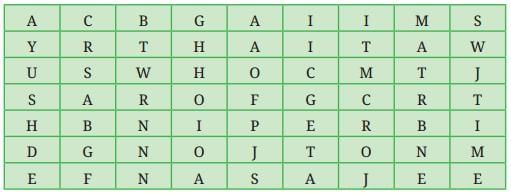
Clipping
The short form of laboratory is lab. In making this short form, the front part of the word is retained and the end part is removed or clipped.
Clipping is a method of making words from larger words in English. There are three clipping methods.
1. Back clipping: a word is made by removing the end part of a word and retaining the front part (exam—examination,
ad—advertisement, gas—gasoline, memo—memorandum, gym—gymnasium, photo—photograph, etc.).
2. Front clipping: a word is made by removing the front part of a word and retaining the end part (phone—telephone,net—internet, bike—motorbike, net—internet, etc.).
3. Middle clipping: a word is made by removing the front and the end parts of the word and retaining the middle part (flu—influenza, fridge—refrigerator, etc.).
Ans: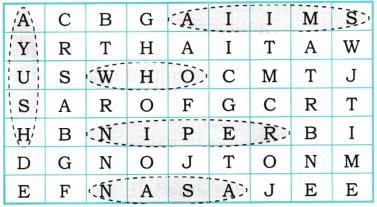
V. Read the following sentence from the text and the table that follows.
…, the foundation was laid by early pioneers like Bibha Chowdhuri… Here the verb is expressed in passive form.
Here the verb is expressed in passive form.
Verbs can be expressed in either active voice or passive voice.
When the subject performs the action, the sentence is said to be in active voice. On the other hand, when the subject receives the action, the sentence is in passive voice.
Generally, sentences written in active voice are considered effective.
However, passive voice is used when the
- action is more important than the doer,
A cure for the disease was discovered.
(The focus is on the discovery, not on who discovered it.) - doer of the action (agent) is obvious,
The national anthem is sung at the beginning of the event.
(It is clear that people sing it, so mentioning the doer is unnecessary.) - doer of the action is unknown.
The car was stolen last night.
(The identity of the thief is unknown.)
Now, complete the following news report with the passive form of verbs given in the box below. (Remember that the verb must agree with the subject.) Last year, significant advancements in medical science 1. __________ in leading medical journals when a new vaccine for malaria 2. __________. The vaccine 3. __________ through several clinical trials and results 4. _________ in those journals. During the trials, blood samples 5. __________ regularly from participants to monitor their immune response. The amount of antibodies produced 6. __________ carefully to assess the effectiveness of the vaccine.
Last year, significant advancements in medical science 1. __________ in leading medical journals when a new vaccine for malaria 2. __________. The vaccine 3. __________ through several clinical trials and results 4. _________ in those journals. During the trials, blood samples 5. __________ regularly from participants to monitor their immune response. The amount of antibodies produced 6. __________ carefully to assess the effectiveness of the vaccine.
Ans:
1. were published
2. was discovered
3. was tested
4. were recorded
5. were taken
6. was measured
VI. Read the following report of an experi¬ment. Rewrite the report using passive verbs wherever necessary.
I conducted an experiment to investigate the effects of light on plant growth. I placed various plants under different light conditions and measured their growth over several weeks. I recorded data daily to track the height of each plant. At the end of the experiment, I analysed the results and found that plants exposed to natural light grew significantly taller than those under artificial light. I concluded that sunlight plays a crucial role in plant development. I presented my findings to the class, highlighting the importance of light in enhancing photosynthesis and overall plant health.
You may begin like this.
An experiment was conducted…
Ans:
An experiment was conducted by me to investigate the effects of light on plant growth. Various plants were placed by me under different light conditions and their growth was measured over several weeks. Data was recorded daily by me to track the height of each plant. At the end of the experiment, the results were analysed by me and it was found that plants exposed to natural light grew significantly taller than those under artificial light. It was concluded by me that sunlight plays a crucial role in plant development. The findings were presented by me to the class, highlighting the importance of light in enhancing photosynthesis and overall plant health.
VII. Read the instructions given in the box on landing of Chandrayaan. Complete the passage by choosing the correct answer from the options given.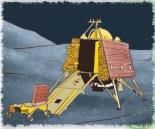 Launch the spacecraft towards the Moon from Earth.
Launch the spacecraft towards the Moon from Earth.
- Position the spacecraft to enter the Moon’s orbit.
- Adjust the spacecraft’s path for landing.
- Slow down the spacecraft as it nears the Moon’s surface.
- Release the rover to explore the surface and collect valuable data
Chandrayaan’s landing mission involves several key steps. First, the spacecraft 1.________ towards the Moon from the Earth. Then, it 2. ________ to enter the Moon’s orbit. After reaching the Moon’s orbit, the spacecraft’s path 3. ________ for landing. Next, the spacecraft 4. ________ as it nears the Moon’s surface. Finally, the rover 5.________ to explore the surface and collect valuable data.
(i)
A. launched
B. were launched
C. was launched
D. is launched
Ans: (C) was launched
(ii)
A. position
B. was positioned
C. is positioned
D. has positioned
Ans: (B) was positioned
(iii)
A. adjusted
B. was adjusted
C. is adjusted
D. were adjusted
Ans: (B) was adjusted
(iv)
A. slowed down
B. was slowed down
C. is slowed down
D. were slowed down
Ans: (B) was slowed down
(v)
A. is released
B. has released
C. were released
D. was released
Ans: (D) was released
Let us listen
I. You will listen to a podcast about Artificial Intelligence. As you listen, answer the following questions by selecting the correct options. Refer to the NCERT Textbook Page 251 for transcript.
1. What is one of the key benefits of AI in the healthcare sector?
(i) Helps doctors communicate faster with patients.
(ii) Provides personalised treatments and faster diagnoses.
(iii) Focuses on cosmetic surgeries to improve appearance.
Ans: (ii) Provides personalised treatments and faster diagnoses.
2. How did AI play a crucial role during the global pandemic?
(i) AI robots monitored patient behaviour in hospitals.
(ii) AI assisted in speeding up the discovery of new medicines.
(iii) AI developed different types of vaccines by itself.
Ans: (ii) AI assisted in speeding up the discovery of new medicines.
3. What example was given regarding AI’s role in renewable energy?
(i) AI is optimising the placement of wind turbines and solar panels in cities.
(ii) AI is promoting alternative energy from wind turbines and solar panels.
(iii) AI is improving the performance of wind turbines and solar panels.
Ans: (iii) AI is improving the performance of wind turbines and solar panels.
4. What does AI offer to teachers in the field of education?
(i) Helps teachers assign grades more quickly.
(ii) Allows teachers to communicate better with students.
(iii) Helps teachers analyse student performance.
Ans: (iii) Helps teachers analyse student performance.
5. What is one of the user-friendly features that AI is enhancing for people with disabilities?
(i) Helps them find better jobs in the mainstream.
(ii) Improves speech recognition and voice command technologies.
(iii) Trains individuals to interact with robots.
Ans: (ii) Improves speech recognition and voice command technologies.
Page No. 245-246
Let us speak
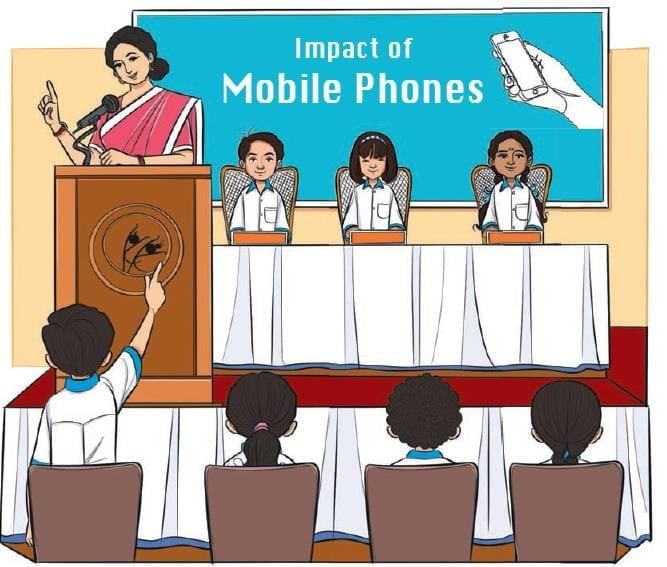
I. Form a group of five. Conduct a panel discussion on the topic, ‘Evaluating the Impact of Mobile Phones—Beneficial or Harmful’. Each student will take on one of the following roles.
- Moderator (initiates and directs the flow of the discussion inviting the speakers to share their views on the subject; at the end sums up the points of discussion and thanks the members of the group)
- Principal (opposed to—focus on discipline in school)
- Teacher (in favour of—partially in favour, educational use with limitations)
- Parent (opposed to—concerned about health and social effects on children)
- Student (in favour of—highlighting the benefits like connectivity and learning)
You may use the cues given below and add your own ideas when speaking.
Principal: As a Principal, I strongly believe mobile phones are largely disruptive because…
Teacher: From an educator’s perspective, I think mobile phones can be valuable but…
Parent: As a parent, I’m concerned that mobile phones pose certain risks to children’s health and social development…
Student: As a student, I feel mobile phones are essential because…
Ans:
1. Moderator: Good morning everyone.
Welcome to today’s panel discussion on the topic “Evaluating the Impact of Mobile Phones—Beneficial or Harmful.” We have with us a Principal, a Teacher, a Parent, and a Student who will share their perspectives. Let’s begin with the Principal.
2. Principal (Opposed to mobile phones):
As a Principal, I strongly believe mobile phones are largely disruptive in schools. They distract students, reduce focus in classrooms, and affect discipline. I have seen students misuse phones for games and social media. In my opinion, mobile phones should be banned in school premises.
3. Teacher (Partially in favour): From an educator’s perspective, I see both sides. Mobile phones can be useful for educational apps, online research, and quick communication. However, students must be taught to use them responsibly. I support their use only under supervision and within limits.
4. Parent (Opposed to mobile phones):
As a parent, I am concerned about the health and social impact of mobile phones. Children spend too much time on screens, leading to eye strain, lack of physical activity, and reduced real- world interaction. It’s becoming harder to engage them in healthy habits.
5. Student (In favour of mobile phones):
As a student, I feel mobile phones are essential tools for learning and staying connected. We use them for online classes, accessing study material, and even solving doubts through educational platforms. They also help us stay in touch with family and friends. We just need to use them wisely.
Moderator (Conclusion): Thank you all for your valuable insights. From today’s discussion, we see that mobile phones can be both beneficial and harmful, depending on how they are used. Responsible use, clear guidelines, and awareness can help us make the best of this technology while avoiding its drawbacks. Thank you for being part of this meaningful discussion!
Let us write
I. Your school recently hosted the Zonal Science Exhibition, in which teams of students from 25 schools participated enthusiastically. As the student editor, write a report on the exhibition to be published in your school magazine. Use the cues given below with your own ideas to compose this report.
- Who was the organiser and who hosted the exhibition?
- When (date and time) and where was it held?
- Why was it held?
- Who participated?
- Who was the Chief Guest?
- What were the competitions held? For example: Science Quiz, Science Models, etc.
- What were the topics of models exhibited? Give details.
- Which team got the trophy for best exhibit?
- What were the observations of the Chief Guest and other visitors?
Points to remember:
1. Write the report in past tense, passive voice, and third person.
2. Follow proper format with a headline, reporter’s name, and three paragraphs.
Ans:
Young Innovators Shine at the Zonal Science Exhibition By: Aarav Mehta, Student Editor The Zonal Science Exhibition 2025 was successfully hosted by Green Valley Public School on 10th August 2025 in the school auditorium. The event was organised under the guidance of the Science Department in collaboration with the District Education Office. The purpose of the exhibition was to promote scientific curiosity, creativity, and innovation among school students. Participation and Events a total of 25 schools from across the zone participated with great enthusiasm. The Chief Guest, Dr. Anjali Rao, a renowned scientist from the Indian Institute of Science, inaugurated the event. The exhibition featured various competitions such as the Science Quiz, Model Display, and Poster Making Contest.
Students presented models on topics like Renewable Energy, Space Technology, Water Conservation, and Artificial Intelligence. Among all entries, the model titled “Smart Irrigation System” by Springdale Public School won the Best Exhibit Trophy for its innovation and practical application.
Observations and Conclusion The Chief Guest appreciated the creativity and scientific temperament displayed by the students. Visitors were impressed by the depth of research and presentation skills. The event successfully created awareness about science and motivated students to explore and innovate. The exhibition concluded with a vote of thanks by the school Principal and the distribution of certificates and mementos.
Page No. 247-248
Let us explore
I. In the recent times, Augmented Reality and Virtual Reality are changing the way students learn. Let us know more about them.
- Augmented reality (AR) enhances a person’s environment by adding digital elements to what can be seen in real time, usually through a smartphone camera.
- Virtual reality (VR) offers a fully immersive experience, replacing the real world with a simulated one.
- Through AR and VR, the students can see and interact with things that they could not interact with in real life. This enables younger students to understand difficult ideas easily.
- To keep up with the times, NCERT has developed the e-Pathshala AR (Augmented Reality) App under the aegis of MHRD, Government of India.
- This App aims to enable students to go beyond textbooks and four walls of the classrooms and learn concepts by directly experimenting rather than only through reading and memorisation.
- This revolutionary effort will change most students from passive listeners to active learners.
- This effort is in line with the Prime Minister’s Digital India vision to empower varied sectors using technology and addressing the triple need of skill, scale, and speed.
Gear up for the new age education!
https://ciet.ncert.gov.in/ar-vr
II. The Government of India has come out with a new set of National Awards in the field of Science, Technology, and Innovation known as ‘Rashtriya Vigyan Puraskar’.
The objective of the Rashtriya Vigyan Puraskar (RVP) is to recognise the notable and inspiring contribution made by the scientists, technologists, and innovators individually or in teams in various fields of science, technology, and technology-led innovation.
1. Vigyan Ratna (VR) award will recognise lifetime achievements and contributions made in any field of science and technology.
2. Vigyan Shri (VS) award will recognise distinguished contributions in any field of science and technology.
3. Vigyan Yuva-Shanti Swarup Bhatnagar (VY-SSB) award will recognise and encourage young scientists up to the age of 45 years, who have made an exceptional contribution in any field of science and technology.
4. Vigyan Team (VT) award to be given to a team comprising three or more scientists/researchers/innovators, who have made an exceptional contribution working in a team in any field of science and technology.
https://pib.gov.in/PressReleaseIframePage.aspx?PRID=1959262
III. A glimpse of women pioneers from different fields.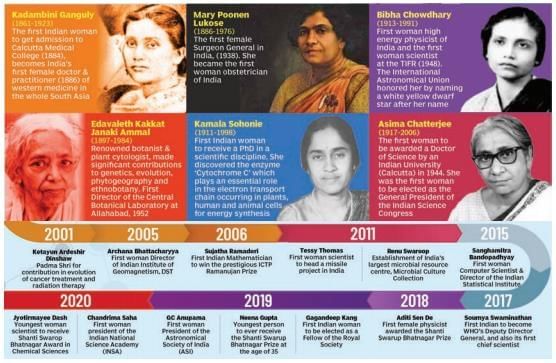 Source: https://www.indiascienceandtechnology.gov.in/sites/all/themes/
Source: https://www.indiascienceandtechnology.gov.in/sites/all/themes/
vigyan/images/Women’s_Scientist_Brochure_Low_Res.pdf
|
60 videos|520 docs|57 tests
|
FAQs on Bibha Chowdhuri- The Beam of Light that Lit the Path for Women in Indian Science NCERT Solutions - English Poorvi Class 8 - New NCERT
| 1. Who was Bibha Chowdhuri and what were her contributions to science? |  |
| 2. What challenges did women face in pursuing careers in science during Bibha Chowdhuri's time? |  |
| 3. How did Bibha Chowdhuri inspire future generations of women in science? |  |
| 4. What was the significance of Chowdhuri's research on cosmic rays? |  |
| 5. In what ways can we continue to support women in science today, following Bibha Chowdhuri's legacy? |  |















